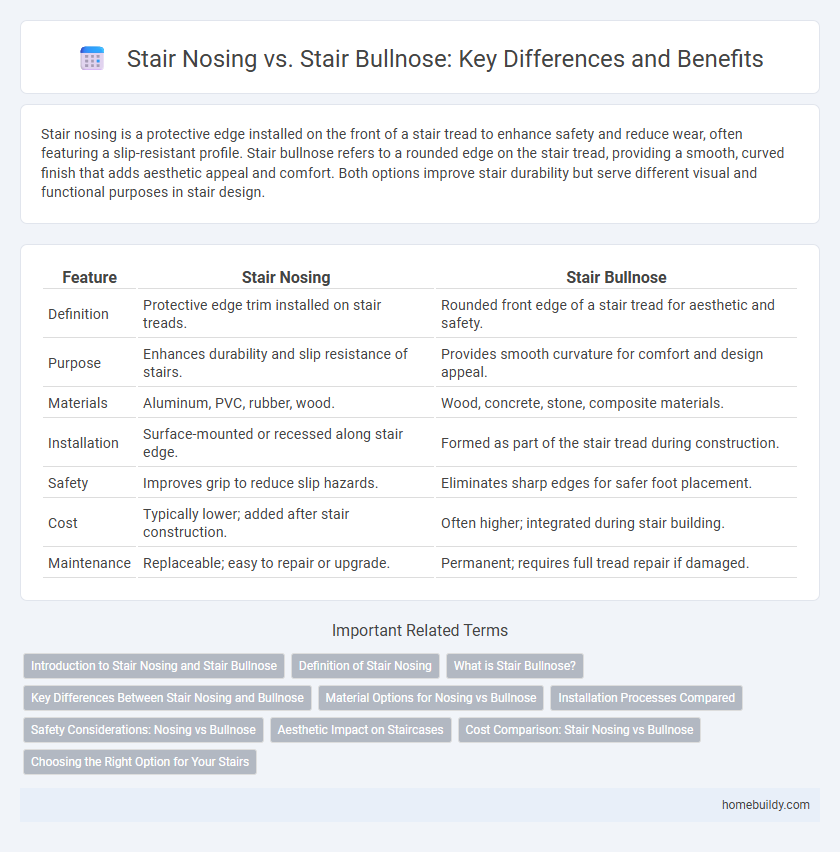Stair nosing is a protective edge installed on the front of a stair tread to enhance safety and reduce wear, often featuring a slip-resistant profile. Stair bullnose refers to a rounded edge on the stair tread, providing a smooth, curved finish that adds aesthetic appeal and comfort. Both options improve stair durability but serve different visual and functional purposes in stair design.
Table of Comparison
| Feature | Stair Nosing | Stair Bullnose |
|---|---|---|
| Definition | Protective edge trim installed on stair treads. | Rounded front edge of a stair tread for aesthetic and safety. |
| Purpose | Enhances durability and slip resistance of stairs. | Provides smooth curvature for comfort and design appeal. |
| Materials | Aluminum, PVC, rubber, wood. | Wood, concrete, stone, composite materials. |
| Installation | Surface-mounted or recessed along stair edge. | Formed as part of the stair tread during construction. |
| Safety | Improves grip to reduce slip hazards. | Eliminates sharp edges for safer foot placement. |
| Cost | Typically lower; added after stair construction. | Often higher; integrated during stair building. |
| Maintenance | Replaceable; easy to repair or upgrade. | Permanent; requires full tread repair if damaged. |
Introduction to Stair Nosing and Stair Bullnose
Stair nosing refers to the protective edge covering installed on stair treads to enhance safety by increasing traction and visibility while preventing wear. Stair bullnose features a rounded edge design that provides a smoother transition on stair corners, offering an aesthetic appeal alongside functional safety. Understanding the distinction between stair nosing's emphasis on durability and safety versus stair bullnose's focus on ergonomic design is essential for appropriate stair finishing decisions.
Definition of Stair Nosing
Stair nosing refers to the projecting edge of a stair tread that enhances safety by providing extra grip and visibility on each step. It is typically made from durable materials such as aluminum, rubber, or wood and is designed to reduce wear on stair edges while preventing slips and falls. Unlike stair bullnose, which features a rounded, smooth finish for aesthetic appeal, stair nosing emphasizes functional safety and durability on high-traffic staircases.
What is Stair Bullnose?
Stair bullnose refers to a rounded edge on stair treads designed to enhance safety and aesthetics by providing a smooth, curved finish. Unlike stair nosing, which often features a more angular or defined edge to protect stair edges and prevent slips, bullnose edges create a softer transition on the stair surface. This design can reduce wear on stair edges and improve overall comfort when walking up or down the stairs.
Key Differences Between Stair Nosing and Bullnose
Stair nosing refers to the protective edge or molding installed on the stair tread's front lip to enhance safety and durability, typically made from materials like aluminum, rubber, or wood. Bullnose stairs feature rounded edges on the treads, creating a smooth, curved finish that improves aesthetics and reduces sharp corners but offers less impact protection compared to stair nosing. The key difference lies in function and design: stair nosing focuses on non-slip safety and edge protection, while bullnose emphasizes rounded aesthetics and comfort.
Material Options for Nosing vs Bullnose
Stair nosing materials typically include aluminum, vinyl, and rubber, offering durability and slip resistance for high-traffic areas. Stair bullnose often features hardwood or composite materials, prioritizing aesthetic appeal and smooth rounded edges that complement traditional wood stairs. Selecting between nosing and bullnose depends on whether durability or design integration is the primary concern in stair renovations.
Installation Processes Compared
Stair nosing installation typically involves attaching an aluminum or vinyl profile to the edge of stair treads using screws or adhesive, offering protection and slip resistance with straightforward, quick mounting. Stair bullnose installation requires the application of a rounded, often custom-cut wooden or stone finish, demanding precise measurements, gluing, and finishing for a smooth, aesthetic edge. The stair nosing process is generally faster and more standardized, while stair bullnose installation is more labor-intensive and tailored to specific design requirements.
Safety Considerations: Nosing vs Bullnose
Stair nosing enhances safety by providing a textured, slip-resistant surface that clearly defines the stair edge, reducing the risk of missteps and falls. Stair bullnose offers a rounded, smooth edge which is aesthetically pleasing but may lack the same level of grip and edge visibility as nosing. For environments prioritizing accident prevention, stair nosing delivers superior traction and visual cues essential for safe stair navigation.
Aesthetic Impact on Staircases
Stair nosing offers a sleek, defined edge enhancing the modern aesthetic of staircases, often emphasizing clean lines and subtle transitions. Stair bullnose features rounded edges that provide a softer, more traditional look, contributing warmth and a classic charm to interior design. Choosing between stair nosing and stair bullnose significantly influences the visual appeal, with nosing aligning with contemporary styles and bullnose complementing timeless, elegant spaces.
Cost Comparison: Stair Nosing vs Bullnose
Stair nosing typically costs less than stair bullnose due to its simpler design and easier installation process, making it a budget-friendly option for stair safety enhancements. Bullnose stair treads, with their rounded edges and thicker profiles, require more material and labor, resulting in higher overall expenses. For projects prioritizing cost efficiency while maintaining durability, stair nosing offers a practical solution compared to the premium pricing of bullnose.
Choosing the Right Option for Your Stairs
Stair nosing enhances safety by providing a slip-resistant edge and protecting stair treads from wear, making it ideal for high-traffic areas. In contrast, stair bullnose features a rounded edge that prioritizes aesthetic appeal and smooth transitions, suitable for residential settings with lighter foot traffic. Selecting the right option depends on balancing durability, safety needs, and design preferences to ensure both functionality and style for your stairs.
Stair nosing vs stair bullnose Infographic

 homebuildy.com
homebuildy.com